Weeping cherry trees are an easy way to add a little magic to your garden. An ornamental tree bred for their flowers and drooping branches. Which are covered in a waterfall of pink or white flowers in spring, with verdant foliage through late spring and summer.
In autumn, their leaves turn the most stunning dappled shades of orange, russets, and reds. With very little effort you can plant and grow a weeping cherry tree at home, which will transform your garden for the better.
Follow our detailed guide, packed with hints and tips for how to grow weeping cherry trees and how to choose the best one for your garden.
More...
What are Weeping Cherry Trees?

Weeping cherry trees are ornamental cherries, producing small dark berries in late summer, following a flush of gorgeous, insect-pollinated, flowers that cover its bows in spring. They are part of the same tree family as cherries and plums (Prunus), but typically don’t carry edible fruit.
Weeping cherry trees grow to around 4m tall in their natural state, but the majority of garden centre varieties are grafted onto dwarf rootstock, which keeps them to a reasonably compact 2m tall.
What you will need to be prepared for though, is giving up a fair amount of space, weeping cherries takes up the same width as height, and will need to be allowed to grow over largely uninterrupted ground.
Ornamental Weeping Cherry Trees' Natural Habitat
Weeping cherries are native to China, but most commonly associated with Japan, where they have been cultivated in ornamental gardens for centuries.
Their ethereal beauty has made them nearly inseparable from the identity of Japan, where they have naturalised throughout the countryside and in cultivated gardens.
Weeping cherries grow in difficult situations but prefer slightly cooler locations than many Australian gardens can manage. However, unlike edible cherry trees, weeping cherries will still blossom and grow in full Australian sunshine, making them a more practical option for many warmer parts of the country.
5 Best Weeping Cherry Trees to Grow in Australia
1. Prunus pendula ‘Plena Rosea’ (Double Weeping Cherry)The gentle, powder pink, flowers of Prunus pendula ‘Plena Rosea’ are capped with a deep pink sepal and open from richly coloured buds in spring. As ornamental cherry trees go, this weeping variety is possibly the most stunning. In part, this is thanks to its double flowers, which provide a bold floral display and release their delicate almond scent slowly throughout the day. |  Source: gardengatetrees.com |
2. Prunus ‘Kiku-Shidare-Zakura’ (Japanese Flowering Cherry)The highly ornamental ‘Kiku-shidare-zakura’ cherry tree is crammed full of blousy blossoms in spring, with a deeper pink than most of its relatives, and a much denser flower form. The flowers grow from quite short stems, making for much more tightly packed colour during flowering. While it isn’t technically a dwarf cherry, it is quite slow growing, and will only reach an ultimate height and spread of around 3x3m. |  Source: vdberk.ro |
3. Prunus x yedoensis ‘Shidare-Yoshino’ (Yoshino Cherry)The Yoshino cherry, as it is c, is my personal favourite, with a subtle beauty that works in any setting. The white flowers, with chalky red centres hang on the pendulous branches. For anyone wanting height, but without the space to allow for a full spread, this is a useful cherry tree, generally reaching 4m tall but with a spread of just 3m when properly pruned. | 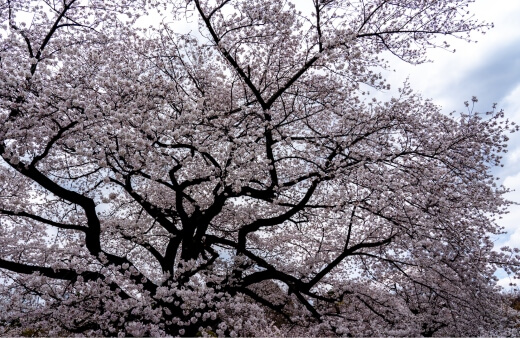 |
4. Prunus ‘Snow Showers’ (‘Hillings Weeping’ cherry)Also known as ‘Hillings Weeping’ cherry, Snow showers are one of the purest whites you will find in any cherry tree. Its crisp green buds open out to reveal bright, ice-white flowers which catch the light exquisitely in early spring. After 5-10 years, the canopy of this 3x3m cherry tree is enchanting to sit beneath. |  Source: gardentags.com |
5. Prunus ‘Marie Mallet’Marie Mallet is a beast of a tree when it reaches its full size, and works best in larger gardens, where its 4x4m spread can be accommodated without completely taking over. Despite its large size, it retains truly delicate features up close and is well worth taking the time to appreciate, especially with its stunningly intricate stamens and anthers, whose tips are boldly red, on translucent stalks. | 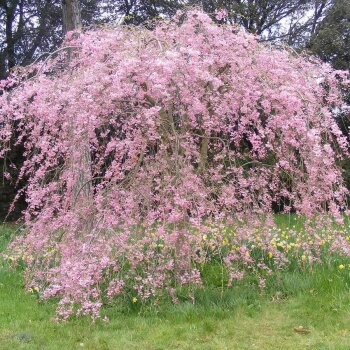 Source: shop.unquadratodigiardino.it |
1. Prunus pendula ‘Plena Rosea’ (Double Weeping Cherry)

Source: gardengatetrees.com
The gentle, powder pink, flowers of Prunus pendula ‘Plena Rosea’ are capped with a deep pink sepal and open from richly coloured buds in spring. As ornamental cherry trees go, this weeping variety is possibly the most stunning.
In part, this is thanks to its double flowers, which provide a bold floral display and release their delicate almond scent slowly throughout the day.
2. Prunus ‘Kiku-Shidare-Zakura’ (Japanese Flowering Cherry)

Source: vdberk.ro
The highly ornamental ‘Kiku-shidare-zakura’ cherry tree is crammed full of blousy blossoms in spring, with a deeper pink than most of its relatives, and a much denser flower form.


Get Your Free Guide:
Master Growing Australian Natives eBook
A Must Have Complete Guide for Every Australian Garden
Get Your Free Guide:
Master Growing Australian Natives eBook
A Must Have Complete Guide for Every Australian Garden
The flowers grow from quite short stems, making for much more tightly packed colour during flowering. While it isn’t technically a dwarf cherry, it is quite slow growing, and will only reach an ultimate height and spread of around 3x3m.
3. Prunus x yedoensis ‘Shidare-Yoshino’ (Yoshino Cherry)

The Yoshino cherry, as it is c, is my personal favourite, with a subtle beauty that works in any setting. The white flowers, with chalky red centres hang on the pendulous branches.
For anyone wanting height, but without the space to allow for a full spread, this is a useful cherry tree, generally reaching 4m tall but with a spread of just 3m when properly pruned.
4. Prunus ‘Snow Showers’ (‘Hillings Weeping’ cherry)

Source: gardentags.com
Also known as ‘Hillings Weeping’ cherry, Snow showers are one of the purest whites you will find in any cherry tree. Its crisp green buds open out to reveal bright, ice-white flowers which catch the light exquisitely in early spring.
After 5-10 years, the canopy of this 3x3m cherry tree is enchanting to sit beneath.
5. Prunus ‘Marie Mallet’

Source: shop.unquadratodigiardino.it
Marie Mallet is a beast of a tree when it reaches its full size, and works best in larger gardens, where its 4x4m spread can be accommodated without completely taking over.
Despite its large size, it retains truly delicate features up close and is well worth taking the time to appreciate, especially with its stunningly intricate stamens and anthers, whose tips are boldly red, on translucent stalks.
Growing Weeping Cherry Trees in Australia
Regardless of the size of the cherry tree you buy, it’s essential to follow some basic instructions to give it the best start in life. Like most fruit trees, even ornamental varieties need feeding, and plenty of root space, but perhaps the most important care tip is to water, water, water right through its first summer in the garden.
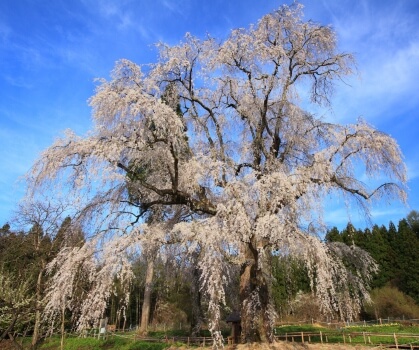
How to Plant Weeping Cherry Trees
Cherry trees are shallow rooted, spreading roots horizontally through topsoil, rather than digging down into the earth. Their thick roots develop to about the same width as the canopy in time.
However, fibrous roots can reach out to at least 3m beyond the canopy once the tree has established, helping to create a better connected and healthier soil structure around the garden.
To accommodate this root growth, dig a hole at least three times the width of the pot you are planting, and loosen the soil at the base to aid drainage.
Place your cherry tree in the ground, and then backfill with garden soil. Once the hole is filled back in with soil, soak the area really, really well. Finally, mulch around the tree with compost or soil improver to lock the moisture in.
Best Soil for Ornamental Cherry Trees
Cherry trees like slightly acidic soil, which helps them to access nutrients. However, provided your ground isn’t strongly alkaline, cherry trees will adapt to most conditions.
If your garden soil is incredibly sandy or free-draining, add soil improver or plenty of organic matter to a larger-than-normal planting hole. This will help with moisture retention.
If you have clay soil, mix soil improver through the earth to improve drainage.
Sunlight Preference
Cherry trees can cope with full sun, but don’t like extreme high temperatures. In fact, almost all Prunus species prefer a period of frost in winter to improve flowers and fruit.
This can be hard to provide in most of Australia, but rarely has any significant negative effect on ornamental weeping cherries.
Watering Weeping Cherries
Cherry trees don’t need much water once they establish as their roots exceed their canopy and search far and wide for water. However, for their first year, it’s essential to water them really deeply around the base of the tree for the first few months after planting (particularly if you plant young trees in late spring).
This helps them to settle into the soil, and gives them a head start while their roots are busier growing than drinking!
Shelter/Exposure
Perhaps the best choice when planting an ornamental cherry tree is how to manage its exposure. Most suburban gardens will be protected from extreme winds and salty air, but the more protection you can give them, the better.
Cherry trees don’t mind wind in nature, but to maximise their flowering time, minimum wind is ideal, for one very simple reason; their blossoms blow off.
Propagating Weeping Cherry Trees
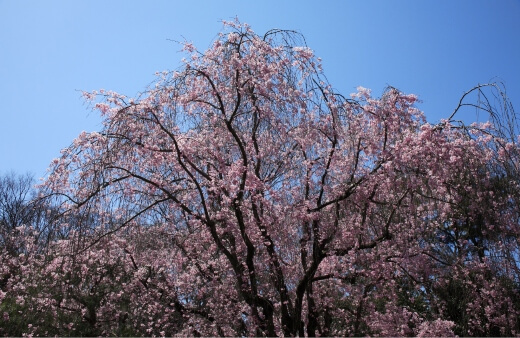
There are three ways to propagate weeping cherry trees; from seed (slowest); from cuttings (easiest); and by grafting (hardest). All work, but the reality for most gardeners is that buying a young sapling from a nursery is affordable, and provides reliable healthy trees.
Grafting weeping cherry trees will require that you have an existing sapling, or some rootstock to work with, but you can follow our guide to grafting cherry trees if you feel like a challenge.
Below, we’ve got details on how to grow weeping cherries from seed, and from cuttings:
Propagating Weeping Cherry Trees from Seed
You can buy weeping cherry seeds from some dedicated growers, but it’s more reliable to plan fresh cherry seeds, also called pits, into fresh compost in winter. This gives them time to chill before sprouting in spring.
If you’re planting cherry seeds any time other than late autumn, it's worth vernalising them. Vernalising is a process of placing cherry pits in the fridge for around 10 weeks, which gives them the chill they naturally need to germinate.
After a chill, plant cherry seeds into any garden compost and keep them moist by covering them with a plastic bag. After about 4 weeks you should see signs of germination.
Keep the pot moist and in bright, but indirect, light for the next few months. When roots appear and its first true leaves have developed you can move them into a slightly larger pot with more compost.
Cherry trees are ready to plant in the garden when their stems are about an inch wide.
Weeping Cherry Tree Propagation from Cuttings
Cuttings are a quicker, and frankly, less time-consuming way to propagate weeping cherries, but can be quite hit and miss., so it’s worth taking a few at a time to avoid disappointment!
Tools:
- Tall plastic pot
- Cutting compost (or compost + perlite)
- Clear plastic bag, or cold frame
- Sharp bypass secatuers (clean)
If you don't have one on hand yet, see our review of the best secateurs available online.
Method:
- Find a section of the previous year’s growth (semi-hardwood) that has not yet developed a thick bark, but has gone past the flexible green stage.
- Fill a tall plastic pot with a cutting compost, and water it until it is moist throughout.
- Select a branch with leaves at its tip and 3-4 leaf nodes below that point.
- Cut the branch from the tree above a node to encourage branching from that point.
- On your cutting, take the lowest section and cut it away to just below a node (where roots will grow), then remove all leaves apart from the top most.
- Dip your cutting in rooting hormone, then push it gently into the compost mix.
- Place it in a cold frame, or cover it with a plastic bag to lock in humidity and moisture.
- After around 2 months, you should have some roots starting to form.
- Test that it is rooted by very gently pulling the cutting upwards. Any resistance means roots are forming.
- When it starts to develop new leaves, remove it from the cold frame, and keep the soil moist.
- When roots emerge from the base of the pot and it is growing happily, it's ready to plant in the garden or a larger container.
Caring for Mature Weeping Cherry Trees
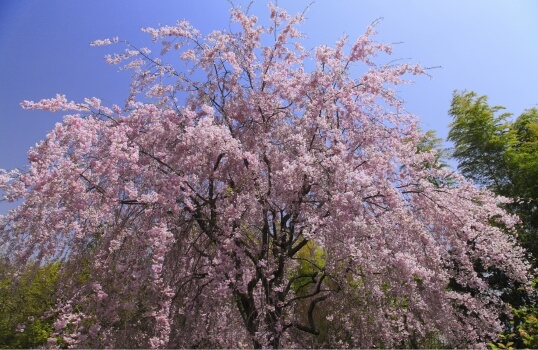
After planting a weeping cherry into the garden, you should leave it alone for the first three years, other than removing damaged or diseased branches.
In its first few years, it’s important to allow the tree to settle into your garden soil and get used to the natural nutrient levels in the garden.
When to Mulch Weeping Cherry Trees
After three years, your weeping cherry should be happily established in the garden and developing into a nice shape. In late spring, feed weeping cherry trees with a thick mulch of garden compost or very well-rotted manure.
Do this once every three to four years, rather than every year.
Pruning Weeping Cherries
Weeping cherry trees should only be pruned to remove dead, damaged or diseased growth. The perfectly domed structure you want can only be achieved naturally, and pruning unnecessarily can lead to a bumpy growth habit, where cut nodes grow out at an angle.
Weeping Cherry Pests and Diseases

Established cherry trees are tough plants, but edible cherries can be frustrating when it comes to pests. Thankfully, weeping cherries and ornamental varieties suffer much less from pests, and those that do attack them rarely cause significant problems.
However, there are a few selective pests in Australia that can cause ongoing damage to weeping cherries:
Cherry Sawfly
Cherry sawfly, or cherry slugs, are the larvae of sawfly, a small wasp-like black fly that specifically targets cherry trees, leaving frustrating orange spots across leaves in late summer.
A useful deterrent can be to use wood ash, from a wood-only fire to dust the entire tree. This might seem extreme, but it works!
Black Cherry aphids
Black cherry aphids work like any other aphid, by attacking young shoots in spring and summer. Their infestations can be really quite intense and there is very little you can do to prevent it, other than introducing predators into the garden by planting pollinator-friendly flowers, and installing bug boxes to encourage bees, wasps, and ladybugs to nest.
Leaf Miners (Apple Leaf Mining Moths)
Apple leaf mining moths might prefer apple trees, but anything in the Prunus or Malus family can suffer the wrath of their voracious caterpillars.
Essentially, their larvae eat into the surface of leaves, creating transparent pits which later develop brown uneven mould. Remove the damage when you see it, and install moth pheromone traps if the moths become a common problem.
Spider Mites, Cherry Thrips & Beetles
If you notice spider mites, thrips, or beetles on your cherry tree, they generally pose a very minimal threat but are a sign that your tree is either too wet or too dry. Consider adding or removing mulch to improve its overall health.
Like most fruit trees, cherries suffer from canker, mildew, and various common fungal problems, but there are three important diseases to be aware of when growing weeping cherry trees:
- Bacterial canker
- Blossom wilt
- Silver leaf
Bacterial canker
Canker is hard to spot before it has already become a problem, and there is only one solution – cut it off. If you see dead bark that has sunken back into pits within the branches or trunk, it is likely to be canker.
If you are in any doubt, check the leaves. They will have small holes caused by nutritional problems and bacteria called ‘shot holes’. To remove the canker, cut the affected area, and everything above it.
Burn the damaged materials to prevent further spread. If you are lucky, cherry trees can recover well from this, but it will change their form, so consider cutting off some healthy growth too, to create a more even canopy after pruning out the canker.
Blossom wilt
Blossom wilt is a fungal disease that causes blossoms and their spurs to drop from the tree. Blossom wilt is generally caused by excess moisture.
If you notice blossoms falling particularly early, the fungus will probably continue into the foliage if it is not treated and return the following year.
Blossom wilt affects most apple, pear, and plum trees, as well as cherries and their ornamental varieties. Treat it with a general-purpose organic fungicide where possible, and try to reduce watering or improve drainage where possible.
Click here to learn more about Blossom wilt and how to prevent it.
Silver leaf
Just like it sounds, silver leaf causes a fine silvery coating across the leaves of cherry trees. It is a fungal disease caused by Chondrostereum purpureum, which enters through wounds (generally pest damage).
Mature cherry trees can usually recover from silver leaf, but young trees and saplings can be badly affected, with fungal infections spreading to the wood.
To stop the spread of silver leaf, remove and burn the affected branches from your weeping cherry.
Weeping Cherry Tree Frequently Asked Questions

How long do weeping cherry trees live?
Weeping cherry trees are generally said to live for around 30-50 years but can live for over 100 given the right care. In my childhood garden, there was a 30-year-old weeping cherry.
30 years later it’s still standing, and incredibly healthy, at around 60 years old.
Can you plant a weeping cherry close to your house?
Don’t plant weeping cherry trees too close to your house as they will spread to their ultimate size without much consideration for your home.
Their roots are unlikely to cause damage, but the tree itself will block light from windows if planted anywhere within 10m of your home.
Do weeping cherry trees lose their leaves in winter?
Weeping cherries are deciduous ornamental trees, which means they lose their leaves each and every winter. As they develop, they become dense with branches though, so provide structure all year round, even in winter when their leaves have fallen.
Do weeping cherry trees smell?
Weeping cherry trees smell incredible in spring, with a similar sweet almond fragrance to their edible relatives. Cherry trees planted in a slightly sheltered spot, with at least a few cold weeks in winter will have a richer fragrance than those planted in warm climates.
For more weeping tree varieties, see our list of the best ones to grow in Australia.
Add Colour to Your Outdoor Space by Growing Weeping Cherry Trees
If you’ve got a small garden or a balcony, you can still grow weeping cherries as beautiful bonsais, or containerise them to limit their growth. Containerised cherry trees will usually only live for around ten years, but that doesn’t mean you can’t grow them!
There is a cherry tree for each and every garden, and weeping cherry trees are an ideal way to add instant character to any outdoor space.
If you weren’t sure before, I hope we’ve convinced you that it’s worth a go, and if nothing else, at least you know how to grow weeping cherry trees at home in Australia now.
Published on September 30, 2022 by Maisie Blevins
Last Updated on February 5, 2024




